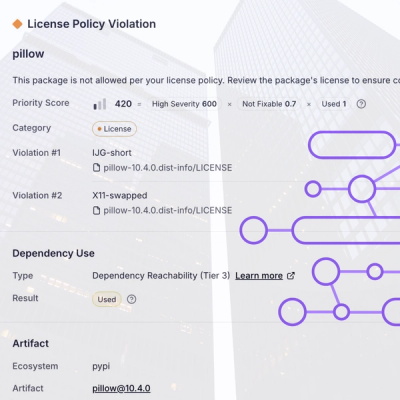
Research
/Security News
Critical Vulnerability in NestJS Devtools: Localhost RCE via Sandbox Escape
A flawed sandbox in @nestjs/devtools-integration lets attackers run code on your machine via CSRF, leading to full Remote Code Execution (RCE).
PyTorch Implementation of Models used for Uncertainty Estimation in Natural Language Processing.
This repository contains implementations of several models used for uncertainty estimation in Natural Language processing, implemented in PyTorch. You can install the repository using pip:
pip3 install nlp-uncertainty-zoo
If you are using the repository in your academic research, please cite the paper below:
@inproceedings{ulmer-etal-2022-exploring,
title = "Exploring Predictive Uncertainty and Calibration in {NLP}: A Study on the Impact of Method {\&} Data Scarcity",
author = "Ulmer, Dennis and
Frellsen, Jes and
Hardmeier, Christian",
booktitle = "Findings of the Association for Computational Linguistics: EMNLP 2022",
month = dec,
year = "2022",
address = "Abu Dhabi, United Arab Emirates",
publisher = "Association for Computational Linguistics",
url = "https://aclanthology.org/2022.findings-emnlp.198",
pages = "2707--2735",
}
To learn more about the package, consult the documentation here, check a Jupyter notebook demo here or a Google collab here.
The following models are implemented in the repository. They can all be imported by using from nlp-uncertainty-zoo import <MODEL>.
For transformer-based model, furthermore a version of a model is available that uses a pre-trained BERT from the HuggingFace transformers.
| Name | Description | Implementation | Paper |
|---|---|---|---|
| LSTM | Vanilla LSTM | LSTM | Hochreiter & Schmidhuber, 1997 |
| LSTM Ensemble | Ensemble of LSTMs | LSTMEnsemble | Lakshminarayanan et al., 2017 |
| Bayesian LSTM | LSTM implementing Bayes-by-backprop Blundell et al, 2015 | BayesianLSTM | Fortunato et al, 2017 |
| ST-tau LSTM | LSTM modelling transitions of a finite-state-automaton | STTauLSTM | Wang et al., 2021 |
| Variational LSTM | LSTM with MC Dropout (Gal & Ghahramani, 2016a) | VariationalLSTM | Gal & Ghahramani, 2016b |
| DDU Transformer, DDU BERT | Transformer / BERT with Gaussian Mixture Model fit to hidden features | DDUTransformer, DDUBert | Mukhoti et al, 2021 |
| Variational Transformer, Variational BERT | Transformer / BERT with MC Dropout (Gal & Ghahramani, 2016a) | VariationalTransformer, VariationalBert | Xiao et al., 2021 |
| DPP Transformer, DPP Bert | Transformer / BERT using determinantal point process dropout | DPPTransformer, DPPBert | Shelmanov et al., 2021 |
| SNGP Transformer, SNGP BERT | Spectrally-normalized transformer / BERT using a Gaussian Process output layer | SNGPTransformer, SNGPBert | Liu et al., 2022 |
Contributions to include even more approaches are much appreciated!
Each model comes in two versions, for instance LSTMEnsemble and LSTMEnsembleModule. The first one is supposed to be
used as an out-of-the-box solution, encapsulating all training logic and convenience functions. These include fitting
the model, prediction, getting the uncertainty for an input batch using a specific metric.
model = LSTMEnsemble(**network_params, ensemble_size=10, is_sequence_classifer=False)
model.fit(train_split=train_dataloader)
model.get_logits(X)
model.get_predictions(X)
model.get_sequence_representation(X)
model.available_uncertainty_metrics
model.get_uncertainty(X)
model.get_uncertainty(X, metric_name="mutual_information")
In comparison, the -Module class is supposed to me more simple and bare-bones, only containing the core model logic.
It is intended for research purposes, and for others who would like to embed the model into their own code base. While
the model class (e.g. LSTMEnsemble) inherits from Model and would require to implement certain methods, any Module class
sticks closely to torch.nn.Module.
To check what arguments are required to initialize and use different models, check the documentation here.
Also, check out the demo provided as a Jupyter notebook here or a Google collab here.
The repository has the following structure:
models: All model implementations.tests: Unit tests. So far, only contains rudimentary tests to check that all output shapes are consistent between models and functions.utils: Utility code (see below)
utils/custom_types.py: Custom types used in the repository for type annotations.utils/data.py: Module containing data collators, and data builders - which build the dataloaders for a type of task and a specific dataset. Currently, language modelling, sequence labeling and sequence classification are supported.utils/metrics.py: Implementations of uncertainty metrics.utils/samplers.py: Dataset subsamplers for language modelling, sequence labelling and sequence classification.utils/task_eval.py: Functions used to evaluate task performance.utils/uncertainty_eval.py: Function used to evaluate uncertainty quality.utils/calibration_eval.py: Function used to evaluate calibration quality.config.py: Define available datasets, model and tasks.defaults.py: Define default config parameters for sequence classification and language modelling (Note: These might not be very good parameters).wandb_run argument to model.fit()!transformers.This repository is by no means perfect nor complete. If you find any bugs, please report them using the issue template, and, if you also happen to provide a fix, create a pull request! A GitHub template is provided for that as well.
You would like to make a new addition to the repository? Follow the steps below:
Adding a new model: To add a new model, add a new module in the models directory. You will also need to implement
a corresponding Model and Module class, inheriting from the classes of the same name in models/model.py and implementing all
required functions. Model is supposed to be an out-of-the-box solution that you can start experimenting right away, whil
Module should only include the most basic model logic in order to be easy to integrate into other codebases and allow tinkering.
Adding a new uncertainty metric: To add a new uncertainty metric, add the function to utils/metrics.py. The function should take
the logits of a model and output an uncertainty score (the higher the score, the more uncertain the model). The function should output
a batch_size x sequence_length matrix, with batch_size x 1 for sequence classification tasks. After finishing the implementation, you can
add the metric to the single_prediction_uncertainty_metrics of the models.model.Model class and multi_prediction_uncertainty_metrics of models.model.MultiPredictionMixin (if applicable).
You would like to add something else? Create an issue or contact me at dennis {dot} ulmer {at} mailbox {dot} org!
FAQs
PyTorch Implementation of Models used for Uncertainty Estimation in Natural Language Processing.
We found that nlp-uncertainty-zoo demonstrated a healthy version release cadence and project activity because the last version was released less than a year ago. It has 1 open source maintainer collaborating on the project.
Did you know?

Socket for GitHub automatically highlights issues in each pull request and monitors the health of all your open source dependencies. Discover the contents of your packages and block harmful activity before you install or update your dependencies.

Research
/Security News
A flawed sandbox in @nestjs/devtools-integration lets attackers run code on your machine via CSRF, leading to full Remote Code Execution (RCE).

Product
Customize license detection with Socket’s new license overlays: gain control, reduce noise, and handle edge cases with precision.

Product
Socket now supports Rust and Cargo, offering package search for all users and experimental SBOM generation for enterprise projects.